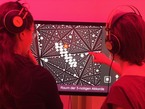Les modules MPE (Mathématiques de la Planète Terre) d’IMAGINARY seront présentés à la Journée Berlinoise des Mathématiques.
Dune Ash
programme
Linux live-cd image with the installed 'dune-ash' simulation program,
alternative installation methods are availabel at
http://dune.mathematik.uni-freiburg.de/dune-ash/download.html
Crédits
This application was developed mainly at the department of applied mathematics at the University of Freiburg. The first version was built in June/July 2011 for the Freiburg Science Fair. Between September and November of 2012 additional features were added for touchscreen support.
Site internet
Contributeurs
OrganisationProf. Dr. D. Kröner (AAM, University of Freiburg), OrganisationDr. M. Nolte (AAM, University of Freiburg), OrganisationTh. Strauch (AAM, University of Freiburg), OrganisationT. Malkmus (AAM, University of Freiburg)
ProgrammingDr. M. Nolte (AAM, University of Freiburg), ProgrammingDr. R. Klöfkorn (IMAGe / NCAR), ProgrammingD. Nies (AAM, University of Freiburg), ProgrammingJ. Gerstenberger (AAM, University of Freiburg), Programming T. Malkmus (AAM, University of Freiburg), ProgrammingA. Pfeiffer (AAM, University of Freiburg)
PicturesSan Jose (Wikimedia Commons), Pictures H. Thorburn (Wikimedia Commons), Pictures J. Gerstenberger (AAM, University of Freiburg)
Dune Ash est un programme de simulation interactif d’éruption de volcan en Europe. Vous pouvez placer un volcan, orienter le vent et étudier la dispersion du nuage de cendres.
Cette application calcule une solution approchée de la dispersion des cendres volcaniques sur l’Europe après une éruption. Après avoir initialisé les données, les résultats sont calculés instantanément.
Les simulations numériques sont souvent utilisées en géophysique, comme pour les prévisions météorologiques ou la prédiction de la propagation de polluants dans l’atmosphère. Les modèles qui décrivent ces phénomènes sont habituellement exprimés sous la forme d’équations aux dérivées partielles (EDPs), dont la résolution est défi mathématique.














